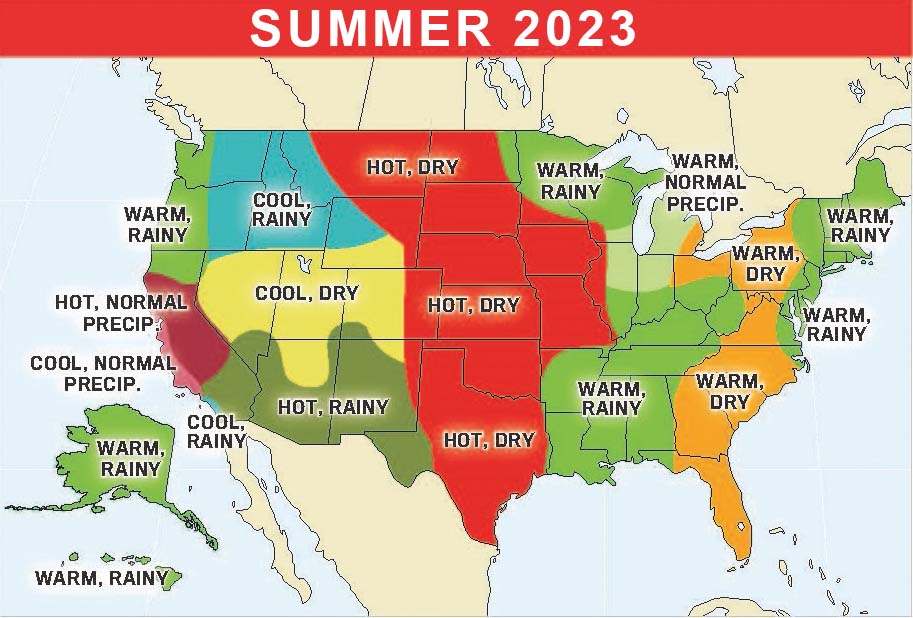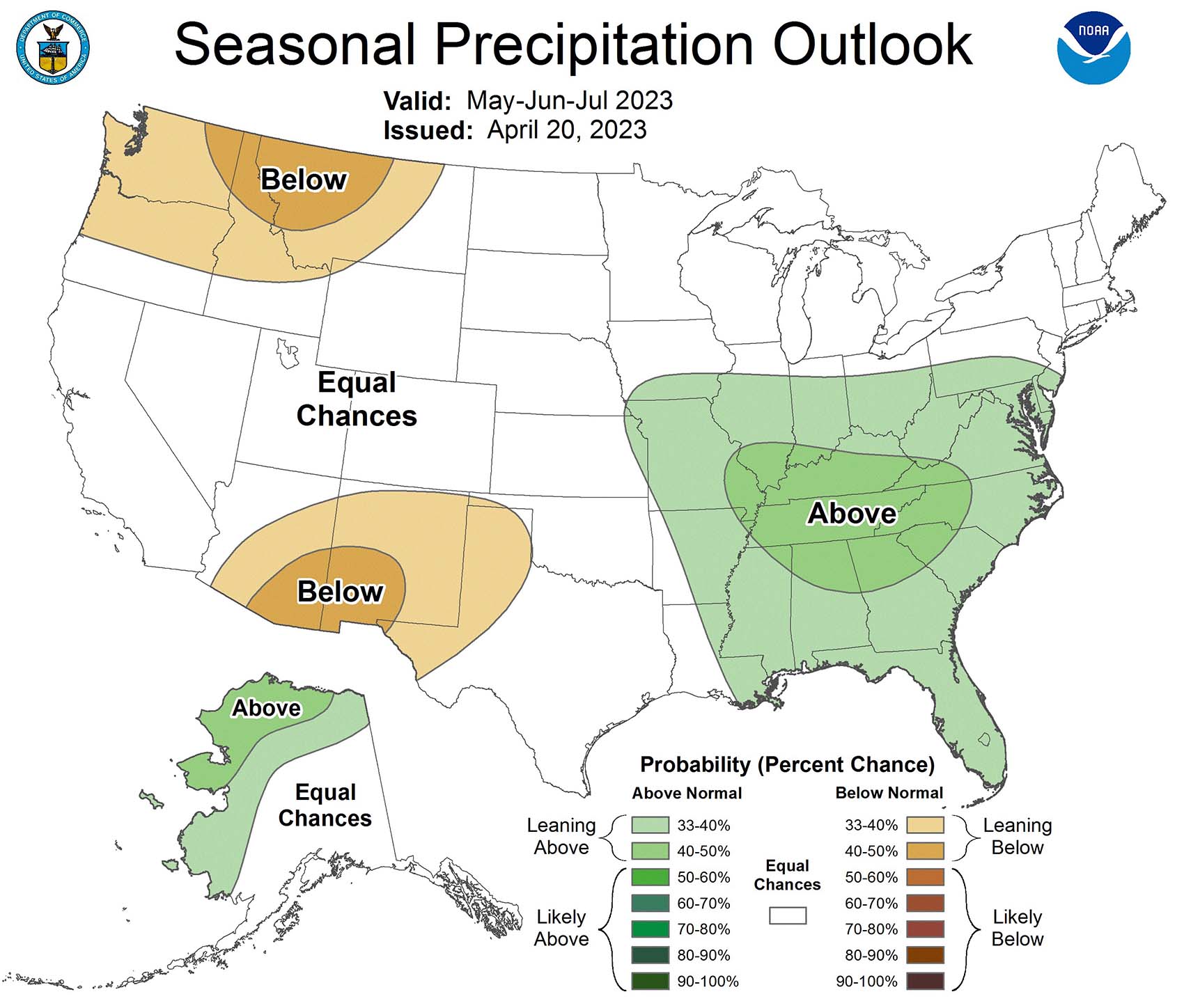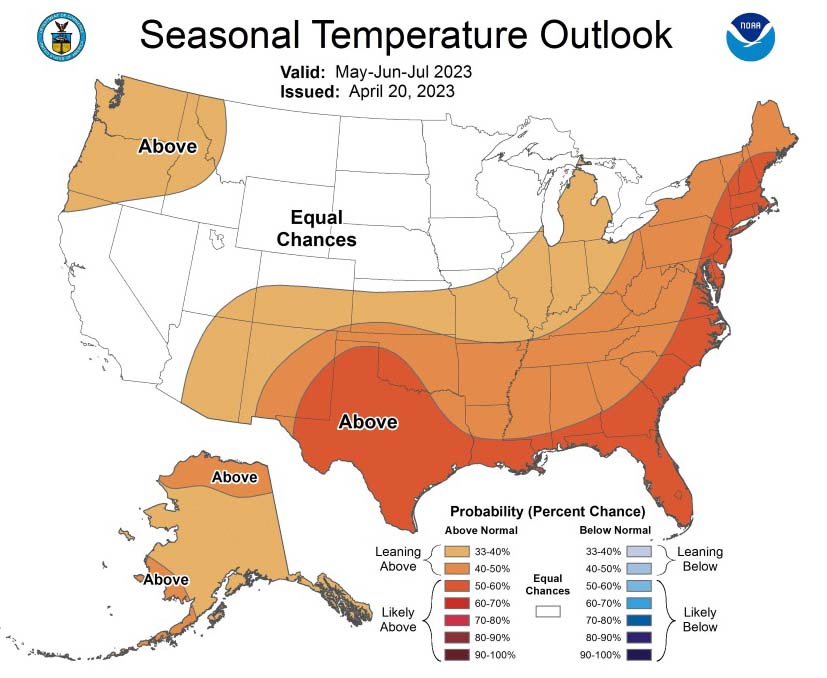*Predictions may vary from expert to expert and are subject to change.*
No matter the area in which an HVACR contractor is located, the summer heat is coming. There’s a lot of talk about whether or not this summer will be an El Niño summer or a La Niña summer. But one things for sure, it’s gonna be a hot one.

Click chart to enlarge
HEATING UP: The Old Farmer’s Almanac predicts above normal temperatures for most of the country this summer. (Courtesy of The Old Farmer’s Almanac)
La Niña generally, in the cold season, is supposed to produce more precipitation in the north and less in the south, but that didn’t happen in California this year — which means HVACR contractors may have to prepare for a dry, hot summer.

Click chart to enlarge
PRECIPITATION: HVACR contractors may need to prepare for more dry than wet heat. (Courtesy of NOAA Climate Prediction Center)
“Right now in the eastern equatorial Pacific, El Niño is coming on fierce,” said Paul Pastelok, senior meteorologist and lead U.S. long-range forecaster at AccuWeather. “The water depths are warming very quickly, which may result in this year being officially named an El Niño year.”
Scott Handel, meteorologist for NOAA’s Climate Prediction Center, said NOAA sees a 70-80% chance of an El Niño in June, July, and August, and the probability only increases later in the summer season.

Click chart to enlarge
MAY-JULY: NOAA predicts above normal and equal chances of summer temperature May-July. (Courtesy of The Old Farmer’s Almanac)
Sarah Perreault, senior editor of The Old Farmer’s Almanac, said her publication's experts predict La Niña replacing the current neutral-to-weak El Niño, which The Old Farmer’s Almanac predicted for the 2022 winter weather forecast. This means hurricane season, beginning on June 1, fortunately might not be as eventful as year’s past.
Right now, whether it’ll turn out to be an El Niño or a La Niña type of summer, summer temperatures are predicted to be above normal around the country. So HVACR contractors are going to have their work cut out for them.
Northeast
Summer temperatures are expected to be above normal with slightly above-normal rainfall, with exceptionally hot periods expected in early and mid-July as well as early-August, said& Perreault.
Pastelok said that it might be a struggle for this region to transition into that consistent hot summer weather. It could be a slower start.
“For pool lovers, it may be a little tough in the beginning if you don't have a heater,” Pastelok said. “But if you're going outside and doing some work, since it's been so unsettled, it should be quite pleasant at times, especially in the evening hours, as we should see some cooler air masses from time to time still come down in June.”
Atlantic Corridor
Temperatures are predicted to be warmer than normal with above-normal precipitation, with some of its hottest periods happening mid-July as well as early to mid-August, said Perreault.
Appalachians
Temperatures are expected to be above normal with below-normal precipitation with the hottest temperatures expected in mid-July, Perreault said.
Southeast
Pastelok projects some wet periods in this region and unsettled weather in the first half of the summer.
“Our wettest areas have been from the lower Mississippi Valley up through the Tennessee Valley, but we could see a lot more wetness coming into the Carolina’s and parts of Georgia and northern Florida,” Pastelok said
Perreault said temperatures are projected to be slightly above normal, with some of the hottest periods in mid- to late June and again in early July, and below-normal rainfall.
Florida
Temperatures are expected to be slightly above normal with below-normal rainfall, with some extremely hot periods in early and mid-June as well as mid-August, Perreault said.
Lower Lakes
Temperatures are expected to be warmer than normal, and rainfall is expected to be below-normal in the eastern part of this region but near normal in the western part. Perreault said the lower lakes will experience their hottest periods in mid-July and then again in early and late August.
Ohio Valley and Midwest
As far as severe weather goes, the AccuWeather forecast predicts the worst of the severe weather may be west of this region in the Midwest and Mississippi Valley.
“But I do think it will come in on occasion. And it may be a little rougher in July,” Pastelok said.
Perreault said The Old Farmer's Almanac expects warmer and wetter than normal temperatures, with the hottest parts of the summer in late June to mid to late July.
Deep South
Perreault predicts a warmer and wetter than normal summer, with some hot periods in mid to late-June, and then again in mid to late-July.
“They are also expecting a possible tropical storm in mid- to late August. Possible,” Perrault said.
Upper Midwest
A warmer and wetter summer is predicted, with some of its hottest periods in late June and then again in early and late August, Perreault said.
Heartland
Temperatures will be hotter and drier than normal, with the hottest periods expected in mid- to late June, mid-July, and early and late August, Perreault said.
Texas-Oklahoma-Kansas, and Nebraska
According to Pastelok, periods of heat can dryness can be expected, but it’ll be a bit unsettled across Kansas and Nebraska at times.
“That battleground between the cooler air east and that warm, hot air in the Southwest doesn't bode well,” Pastelok said. “I think it actually increases the severe weather threat for that region in June and July, especially for the central Plains.”
Perreault said to expect some of the hottest temperatures in this region in late June, early to mid-July, and late August, with a possible tropical storm threat in late July and then again in mid- to late August.
High Plains
This region can expect a hotter and drier than normal summer, with some of the hottest temperatures in mid-June, early July, and early August, Perreault said.
Handel said that in the southern high plains, the soil moisture is currently below normal, which leads NOAA to have a higher confidence of above-normal temperatures in this region, with probabilities ranging from 50-60%.
Intermountain
“Temperatures are expected to be cooler than normal with above-average rainfall in the north part of this region and below normal in the south,” Perreault said. “Their hottest periods will be in mid to late-July and early August.”
Desert Southwest
Temperatures are expected to be hotter than normal with slightly above-normal rainfall. The hottest temperatures are expected to be in early and mid-June and then again in early and late-July, Perreault said.
Pastelok said for this region, AccuWeather looks at when the monsoon starts, and this year looks later start, much later than the last two years and slightly later than the normal (around July 3 for southern Arizona). He doesn’t predict it will be as big as the monsoons from the last two years. He also predicts that fire season will continue a few weeks longer than the last couple of years.
“And then the monsoon will come in sporadic throughout New Mexico, Arizona, and southern Colorado, ending the wildfire threat late summer for this region,” he said.
Pacific Northwest and Northern Rockies
Handel said NOAA is forecasting a 40 to 50% chance of above-normal temperatures in this region, covering the entire state of Oregon and Washington, and adjacent areas of the Northern Rockies and Northern California.
Pastelok said this region is a ridiculously tricky forecast going forward because of the water temperatures off the West coast.
“There's even discrepancies and talks in our own long-range team about what's going to materialize in the northwest and a lot of it is dictated by the water temperatures in the Northern Pacific,” Pastelok said. “They are really cool right now for this time of year.”
All this means that while areas east of the Cascades get hotter, it probably won’t happen as quickly in the big northwest cities.
But east of the cascades, Pastelok projects it heating up pretty quickly in mid- to late July and continuing all the way through August. He also predicts wildfires breaking out pretty significantly in this area, including Montana.
“I do believe that zone is under risk for higher wildfire threat here in the late summer — hotter and drier than normal conditions — and that’s something to look out for,” Pastelok said.
Perreault said it's forecasted to be a wetter-than-normal summer.
Pacific Southwest
Temperatures will be slightly below normal along the coast, and warmer than normal inland, with the hottest periods in mid-June and early and late July. Rainfall in this region is expected to be above normal in the south and near normal in the north, Perreault said.
Handel said for most of California and a lot of the Great Basin, (which includes most of Nevada and Utah), NOAA is favoring above-normal temperatures at a 33-40% confidence.
Alaska
Handel said NOAA has the highest confidence in the forecast of the southern part of the state, favoring the chance of above-normal temperatures at 40-50%.
“We also have relatively higher confidence for the North Slope, which is partially due to reduced sea ice extent this year … which might allow that part of Alaska to be a bit milder than usual,” Handel said.
Perreault said this region will experience a warmer-than-normal summer with above-normal precipitation, with the hottest temperatures in early and late July.
Hawaii
Perreault said The Old Farmer's Almanac predicts above-normal rainfall and slightly above-normal temperatures, with the hottest periods happening in early August.



Report Abusive Comment